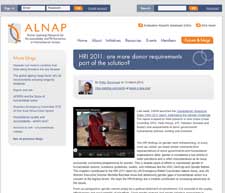March 13, 2012
By Philip Tamminga
Last week, DARA launched the Humanitarian Response Index (HRI) 2011 report: Addressing the Gender Challenge. The report is based on field research in nine crises (Chad, Colombia, DRC, Haiti, Kenya, oPt, Pakistan, Somalia and Sudan) and assessments of donor governments’ humanitarian policies, funding and practices.
The HRI findings on gender were disheartening. In every crisis we visited, we heard similar comments from representatives of donor governments and humanitarian organisations alike: gender is considered a low priority in relief operations and is often misunderstood as an issue exclusively concerning programming for women. This is despite years of efforts to mainstream gender in humanitarian actions, numerous guidelines, toolkits, and initiatives like the IASC GenCap and Gender Marker. The chapters contributed to the HRI 2011 report by UN Emergency Relief Coordinator Valerie Amos, and UN Women Executive Director Michelle Bachelet show that addressing gender gaps in humanitarian action is a concern at the highest levels. We hope the HRI findings are a modest contribution to increasing awareness of the issues.
From our perspective, gender cannot simply be a political statement of commitment; it is essential to the quality, effectiveness and accountability of aid efforts. Good gender analysis and gender sensitive approaches in programme design, implementation, monitoring and evaluation are essential to meet the fundamental humanitarian principle that aid is impartial, non-discriminatory and based on needs.
It is not often that the HRI advocates for donors to add more requirements on their funding for humanitarian organisations – aid delivery is difficult enough as it is. However, as pointed out in several other recent studies, (like these from Tufts and Norad), simple measures like requiring sex and age disaggregated data (SADD) in programme design and reporting, or aligning funding to the Gender Marker would be an important first step in ensuring gender issues are adequately addressed. Beyond this, donors and their partners must go one step further and ask what the data means and how it can be used to influence better quality programming, results and accountability for affected populations. And of course, this should not be limited to gender alone: important gaps remain in recognising and addressing issue around age and disability in humanitarian actions.
More discouraging still, after five years of the HRI initiative, many of the issues we identified in previous HRI reports still persist, such as politicisation of aid, lack of attention to prevention, preparedness and risk reduction, or the need for greater transparency and accountability towards crisis-affected populations. Without a doubt, the ability of the humanitarian sector to deliver assistance has improved over time, in part due to the support and efforts of many donor governments for ongoing reform efforts. The HRI research findings – amply supported by the evidence of many evaluations – show that while reform efforts have been generally positive, the results are uneven across crises and have been unsuccessful at resolving many of the underlying issues affecting needs and vulnerabilities.
Our concern is that the pace of reform efforts may be too slow for the humanitarian sector to be able to adequately meet current needs, much less prepare for, anticipate, mitigate and respond to a trend of increasingly complex crises in the coming decade. What is needed is a major shift in direction for the sector, focused efforts to anticipate and prepare for the future challenges we will collectively face, and to build the necessary capacities and competencies to ‘get ahead of the game’ and minimise the human costs and impacts of humanitarian crises. Part of the shift will require traditional donors and humanitarian actors to reach out to other players, ranging from local actors, new and non-traditional donors, or the private sector. It will also require better understanding of the barriers that have so far impeded efforts to adopt good practices.
In the next phase of the HRI, we intend to explore these issues in greater depth. Through a wide consultation process, we would like to collectively rethink what good donor practice means in today’s context, and where it needs to be in the coming decade. It may be time to go beyond the current framework set out in the Good Humanitarian Donorship (GHD) declaration and re-define the essential elements that makes any donor or funder of humanitarian actions – whether a government, philanthropic organisation, private sector company or individual – maximise the impact of their contributions to benefit people vulnerable to or affected by crises. What do you think? Is it time for a major rethinking of humanitarian aid and donor practices?

Share this